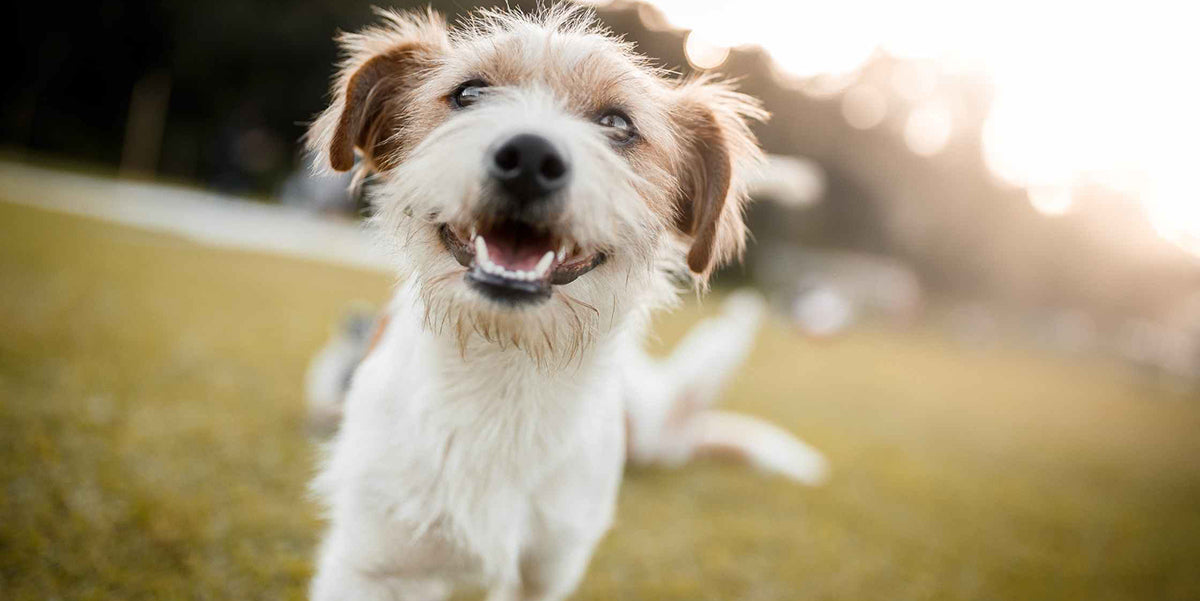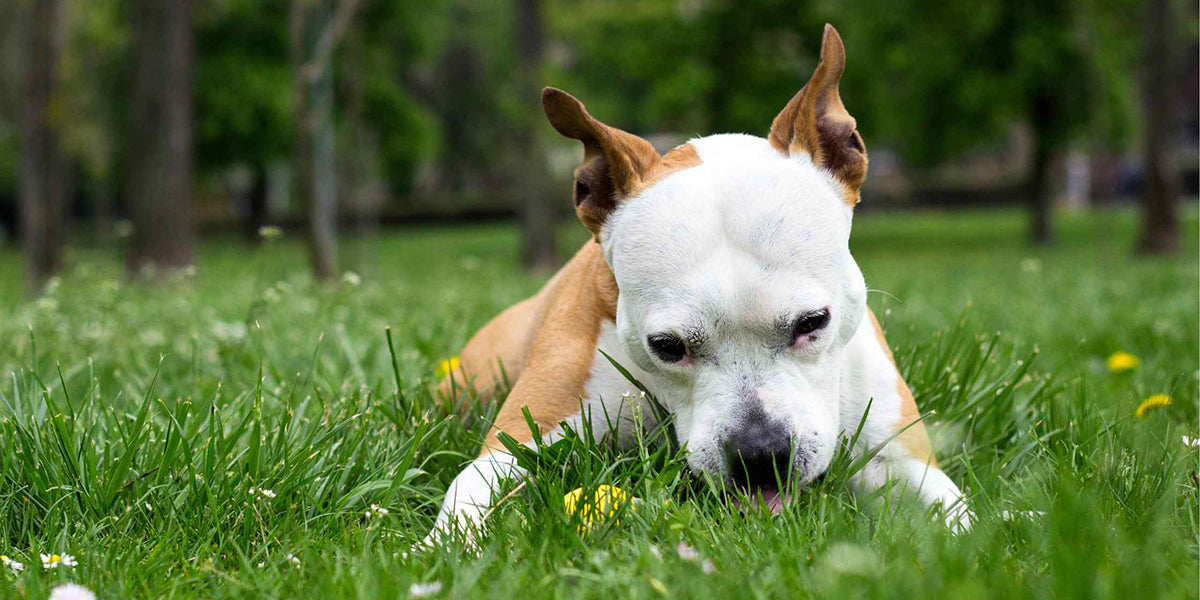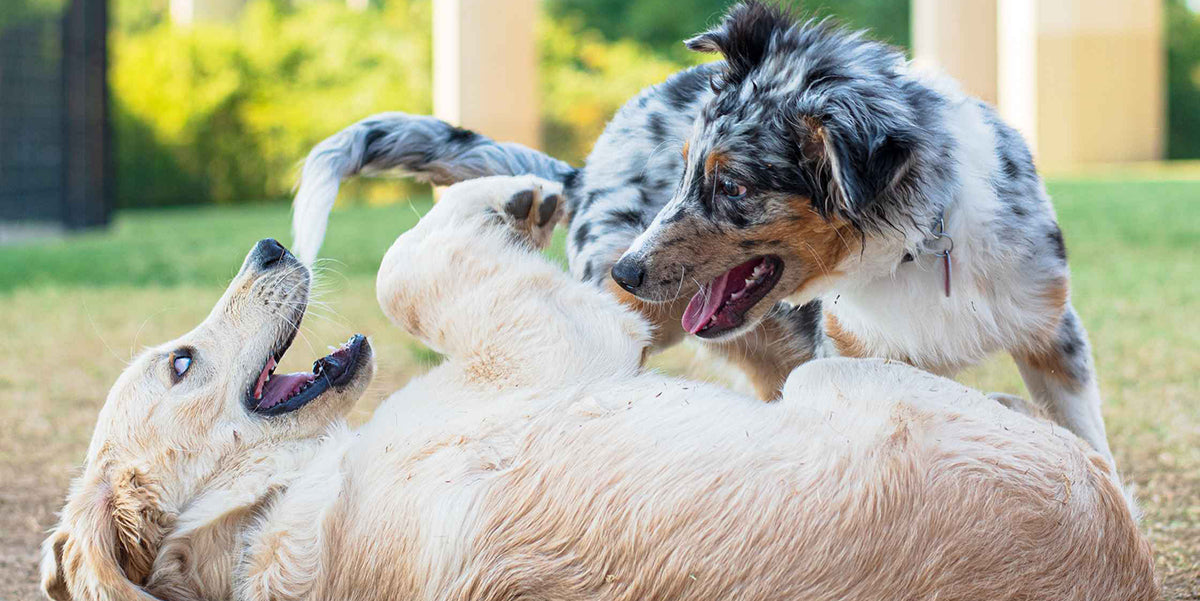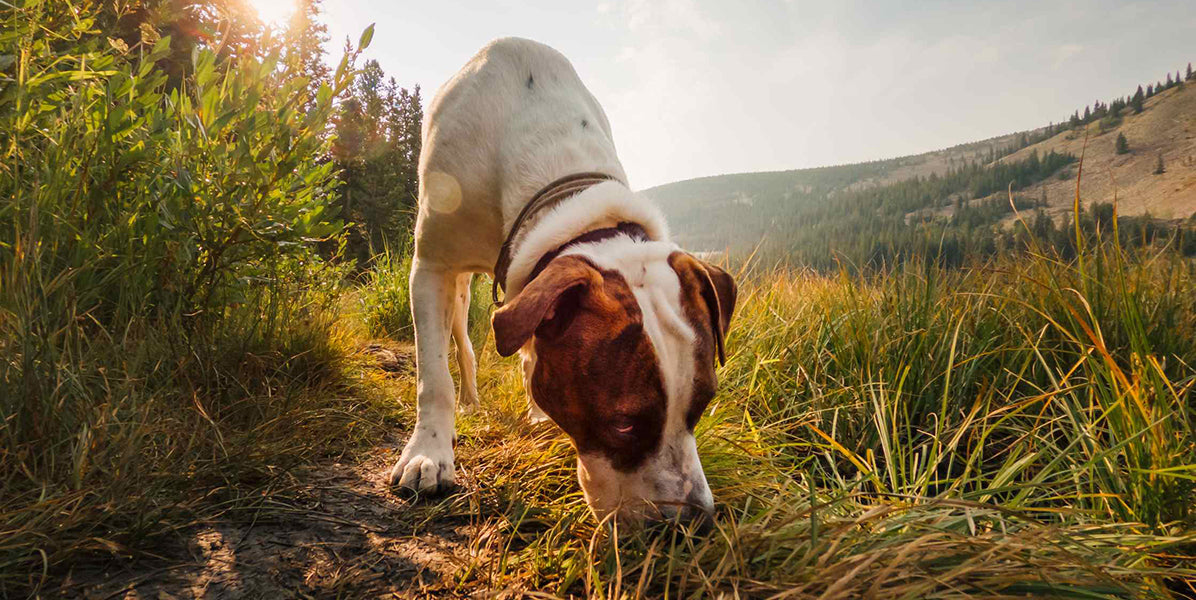Decoding dog body language can be complicated, but it is paramount for fostering effective communication. It also builds a strong bond with your dog.
Dogs primarily communicate through nonverbal cues. Deciphering their body language allows us to bridge the gap in communication and gain insight into their emotions and intentions.
Recognising signs of relaxation, excitement, fear, or discomfort let us tailor our actions to ensure our dogs feel safe and secure. Moreover, it aids in preventing misunderstandings that may arise from misinterpreting their behaviours. See the full Dog Body Language Chart in detail.
CALM supplement and CALM + LAMB Functional Treat – a dynamic duo designed to bring calm and comfort to your dog.
Our specially formulated CALM supplement is crafted with a blend of natural ingredients that work harmoniously to help reduce anxiety-related aggression and fear in dogs. Whether it's the subtle signs of unease or more pronounced behavioural challenges, our CALM supplement offers a holistic approach to promoting relaxation and well-being.
Decoding Dog Body Language
Interpreting a dog's behaviour requires considering all these cues together, as well as the context in which they are displayed. This holistic approach helps us accurately understand the dog's emotional state and intentions.
Aggressive Dog Body Language

Signs of Aggression are:
Tail: Upright, away from the body, can be wagging fast
Ears: Forward or pinned back close to the head
Eyes: Narrow, intimidating stare
Mouth: Lips drawn back with teeth showing, nose wrinkled
Body: Tense, leaning forward with hackles up
Vocalisation: Growling, barking, and snarling.
Aggression in dogs can stem from a variety of factors, and it's crucial to identify and address the underlying issues for the safety and well-being of both the dog and those around them. Read more about what causes dog aggression
Some potential reasons for dog aggression include:
- Fear or Anxiety: Dogs may become aggressive when they feel threatened or fearful. Aggression can be a defensive response to perceived danger.
- Territorial Behaviour: Dogs might display aggression to protect their territory or personal space, especially when unfamiliar people or animals approach.
- Resource Guarding: Aggression can arise when dogs are protective of their food, toys, or other valuable items. They may perceive others as threats to these resources.
- Pain or Discomfort: Dogs in pain or discomfort may react aggressively to avoid being touched in sensitive areas. Joint pain is the most common health issue in dogs. Read more on Understanding the Underlying Causes of Joint Pain in Dogs
- Lack of Socialisation: Poor socialisation during a dog's critical development period can lead to fear or aggression towards unfamiliar people, dogs, or situations.
- Medical Issues: Some medical conditions, such as thyroid imbalances or neurological problems, can influence behaviour and potentially lead to aggression.
- Dominance: Some dogs might display aggressive behaviours to establish their perceived dominance in certain situations.
- Previous Experiences: Dogs with a history of trauma, abuse, or negative interactions may exhibit aggression as a defensive response.
- Genetic Predisposition: Breed characteristics and genetics can play a role in predisposing some dogs to certain aggressive behaviours.
It's vital to pick up on aggressive behaviour early because:
- Safety: Aggressive behaviour poses a risk to people, other animals, and the aggressive dog itself. Recognising it allows us to take necessary precautions to prevent harm.
- Quality of Life: Addressing aggression enhances a dog's overall well-being by reducing stress, anxiety, and negative experiences.
- Legal and Ethical Responsibilities: As dog owners, we have a responsibility to ensure our dogs' behaviour does not harm others or create legal issues.
- Human-Animal Bond: Addressing aggression improves the relationship between the dog and its owners, fostering a trusting and positive bond.
- Community Interaction: Properly managed aggression allows dogs to have positive interactions with people and other animals, contributing to community safety and harmony.
What you can do to help your dog manage aggression
- Effective Training: Early identification of aggression enables timely intervention through proper training and behaviour modification, improving the dog's behaviour and reducing the likelihood of incidents.
- Wellness check: Consult with your vet to ensure your dog does not have any underlying health issues or pain contributing to the aggression.
- Calming Supplements: Help them stay calm by providing them with a calming supplement like PetWell's all-natural CALM supplement and CALM + LAMB functional treats infused with a calming supplement.
- Remove the Trigger: Remove them from situations that trigger their aggression.
Anxious Dog Body Language

Signs of Anxiety are:
Tail: Stiff and out horizontally from the body or between their legs
Ears: Up and pointing forward
Eyes: Wide open with whites showing
Mouth: Mouth slightly opened, may be yawning or panting
Body: Tense, body lowered to the ground, head down
Vocalisation: Whining, growling, or barking
Read more on 10 Signs of Anxiety in Dogs
Some common causes of dog anxiety include:
- Separation Anxiety: Dogs may experience distress when left alone, leading to behaviours like destructive chewing, excessive barking, or house soiling.
- Lack of Socialisation: Poor socialisation during a dog's critical development period can result in fear and anxiety towards unfamiliar people, dogs, or environments.
- Changes in Routine or Environment: Moving to a new home, changes in family dynamics, or alterations in daily routines can trigger anxiety in dogs.
- Noise Phobias: Dogs might become anxious during thunderstorms, fireworks, or other loud noises, leading to trembling, hiding, or attempting to escape.
- Medical Issues: Certain medical conditions, such as thyroid imbalances or hormonal changes, can contribute to anxiety-like behaviours.
- Past Trauma or Abuse: Dogs with a history of traumatic experiences or abuse may develop generalised anxiety due to their negative associations.
- Genetics: Some dogs may have a genetic predisposition to anxiety due to their breed or individual temperament.
- Ageing: Cognitive dysfunction syndrome (like dementia in humans) can cause anxiety-like symptoms in older dogs.
- Pain or Discomfort: Dogs in pain may display anxious behaviours as they try to cope with their discomfort.
- Owner's Behaviour: Dogs can pick up on their owners' emotions. If an owner is anxious or stressed, their dog might also feel uneasy.
Why recognising and addressing dog anxiety is important
- Quality of Life: Identifying anxiety helps improve the dog's emotional well-being, reducing their stress and promoting a happier life.
- Behavioural Issues: Untreated anxiety can lead to undesirable behaviours such as aggression, destructive chewing, excessive barking, or compulsive behaviours.
- Human-Animal Bond: Addressing anxiety strengthens the bond between dogs and their owners, fostering trust and positive interactions.
- Preventing Escalation: Addressing anxiety early prevents it from worsening over time, which can make treatment more challenging.
- Effective Management: Recognising anxiety allows for the implementation of effective strategies, such as behaviour modification, training, and, if necessary, veterinary intervention.
- Community Interaction: Well-managed anxiety helps dogs have positive interactions with people and other animals, contributing to community safety and harmony.
What you can do to help your dog manage anxiety
- Effective Training: Training can be an effective way to ease their anxiety. Dogs often feel safer when they have structure and respond well to commands that guide them on what to do.
- Wellness check: Consult with your vet to ensure your dog does not have any underlying health issues or pain contributing to their anxiety.
- Food: Diet-related factors, including ingredients, unbalanced diets, sudden changes, intolerances, and excessive commercial treats, can contribute to dog anxiety by causing discomfort, digestive issues, or allergic reactions. Read more on the Creating a Balanced Diet for Your Dog here
- Calming Supplements: Help then stay calm by providing them with all-natural calming supplement like PetWell's CALM supplement and CALM + LAMB functional treats infused with a calming supplement.
- Remove the Trigger: Remove them from situations that trigger their anxiety.
Dominant Dog Body Language
Signs of Dominance are:
Tail: Stiff and out horizontally from the body
Ears: Up and pointing forward
Eyes: wide open, intimidating stare
Mouth: Closed or slightly open mouth
Body: Tall posture, may have heckles up
Vocalisation: Low strong growl, grunt or snarl
Some potential causes and factors associated with dominance behaviour in dogs include:
- Misinterpretation of Leadership: Dogs might exhibit dominant behaviour if they perceive a lack of clear leadership from their human owners.
- Lack of Socialisation: Poor socialisation during a dog's critical development period can result in dominance behaviours towards other dogs or people.
- Territorial Instincts: Some dogs may show dominance behaviours when they want to establish and protect their territory or personal space.
- Resource Guarding: Dogs may display dominance when guarding food, toys, people or other valuable items.
- Genetic Predisposition: Certain breeds might have a higher tendency to exhibit dominant behaviour due to their historical roles and characteristics.
- Inconsistent Training: Inconsistent or inadequate training and boundaries can lead to confusion about their role within the family, prompting dominant behaviours.
Recognising dominance-related behaviour in dogs is important for several reasons:
- Safety: Unaddressed dominance behaviour can escalate into aggressive behaviour, potentially leading to conflicts with other dogs or even people.
- Healthy Relationships: Identifying dominant behaviours allows for establishing a healthier dynamic.
- Avoiding Conflicts: Prevent conflicts and challenges among multiple dogs in a household or when interacting with other dogs.
- Preventing Injuries: Reduce the risk of confrontations or injuries, especially if the dog tries to assert dominance over humans or other animals.
What you can do to help your dog manage dominance behaviour
- Promoting Calmness: Addressing dominant behaviour contributes to a calmer and more peaceful living environment, benefiting both the dog and the human family.
- Positive Socialisation: Establish clear leadership through positive reinforcement training, controlled interactions, desensitisation, and consistency in routines, with the aim of fostering positive social interactions and a well-adjusted demeanour. A professional dog trainer can help with this.
Fearful Dog Body Language

Signs of Fear are:
Tail: Tucked between its legs
Ears: Sitting low or pinned back to their head
Eyes: Darting back and forth, wide open with whites showing
Mouth: Lips drawn back exposing teeth
Body: Tense, body lowered to the ground, head down
Vocalisation: Apprehensive whining, yelp or short barks
Some potential reasons for fearful behaviour in dogs include:
- Past Trauma or Abuse: Dogs with a history of traumatic experiences or abuse may develop fear as a defensive response to certain stimuli.
- Lack of Socialisation: Insufficient exposure to new people, animals, and environments during the critical development period can lead to fear of the unfamiliar.
- Negative Experiences: A single negative experience, such as a loud noise or a sudden event, can leave a lasting fear response.
- Genetic Predisposition: Certain breeds may have a genetic tendency to be more anxious or fearful.
- Change or Instability: Major life changes, like moving to a new home or changes in the household, can trigger fear in dogs.
- Inadequate Training: Dogs without proper training might feel overwhelmed or fearful in new situations.
Recognising fearful behaviour is important for several reasons:
- Emotional Well-Being: Addressing fear promotes a dog's emotional health and overall well-being, reducing stress and anxiety.
- Behavioural Issues: Untreated fear can lead to avoidance behaviours, aggression, or other undesirable behaviours. See blog
- Human-Animal Bond: Addressing fear strengthens the bond between dogs and their owners, fostering trust and positive interactions.
- Preventing Aggression: Fearful dogs might react aggressively if they feel cornered or threatened. Recognising fear helps prevent aggressive responses.
What you can do to help your dog manage fear
- Create a Safe Environment: Provide a quiet, safe space where your dog can retreat and feel secure.
- Calming Supplements: Help then stay calm by providing them with an all-natural calming supplement like PetWell's CALM supplement and CALM + LAMB functional treats infused with a calming supplement.
- Desensitisation: Gradually expose your dog to triggers at a distance, rewarding calm behaviour to reduce fear.
- Training: Teach basic commands to build confidence and provide a sense of control. See 7 Practical Dog Training Techniques
- Routine: Stick to a consistent routine to provide predictability and reduce anxiety.
- Socialisation: Gradually expose your dog to new people, places, and experiences in a positive way.
Decoding dog body language is important for effective communication and building a strong bond with your dog |
In Summary
When we can identify how our dogs are feeling through their body language, we can better address their needs and provide them with the care, attention, and support they require. Whether it's recognising signs of aggression, anxiety, or fear, this knowledge empowers us to respond in a way that fosters trust and strengthens the bond we share with our furry companions.
Ultimately, decoding dog body language is a cornerstone of effective communication, enabling us to create a harmonious and enriching relationship with our dogs.
Disclaimer: The entire contents of this email and website are not to be taken as medical advice. The team at Pet Squad Pty Ltd trading as PetWell encourages you to make your own pet healthcare decisions based on your research and in partnership with a qualified pet healthcare professional.
































